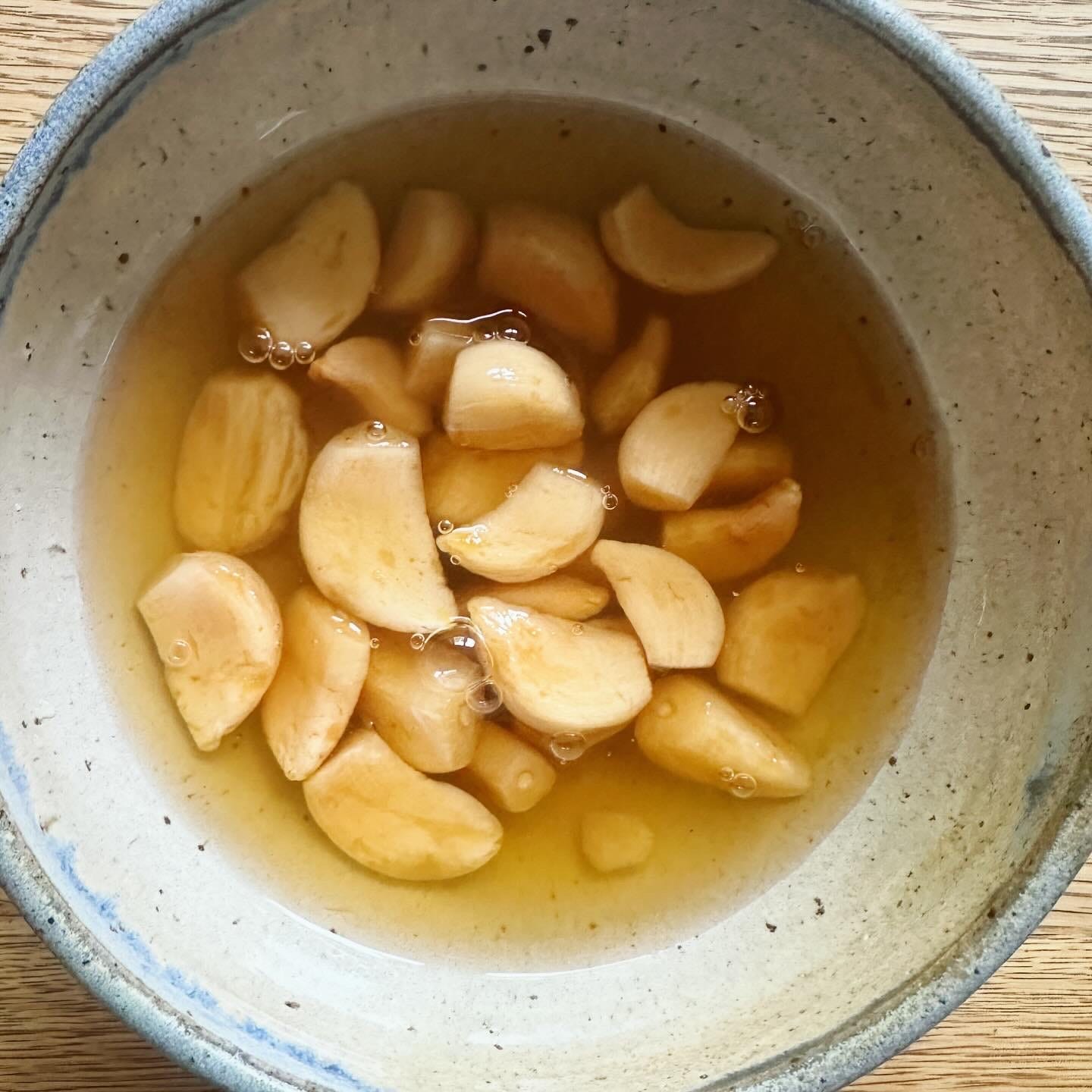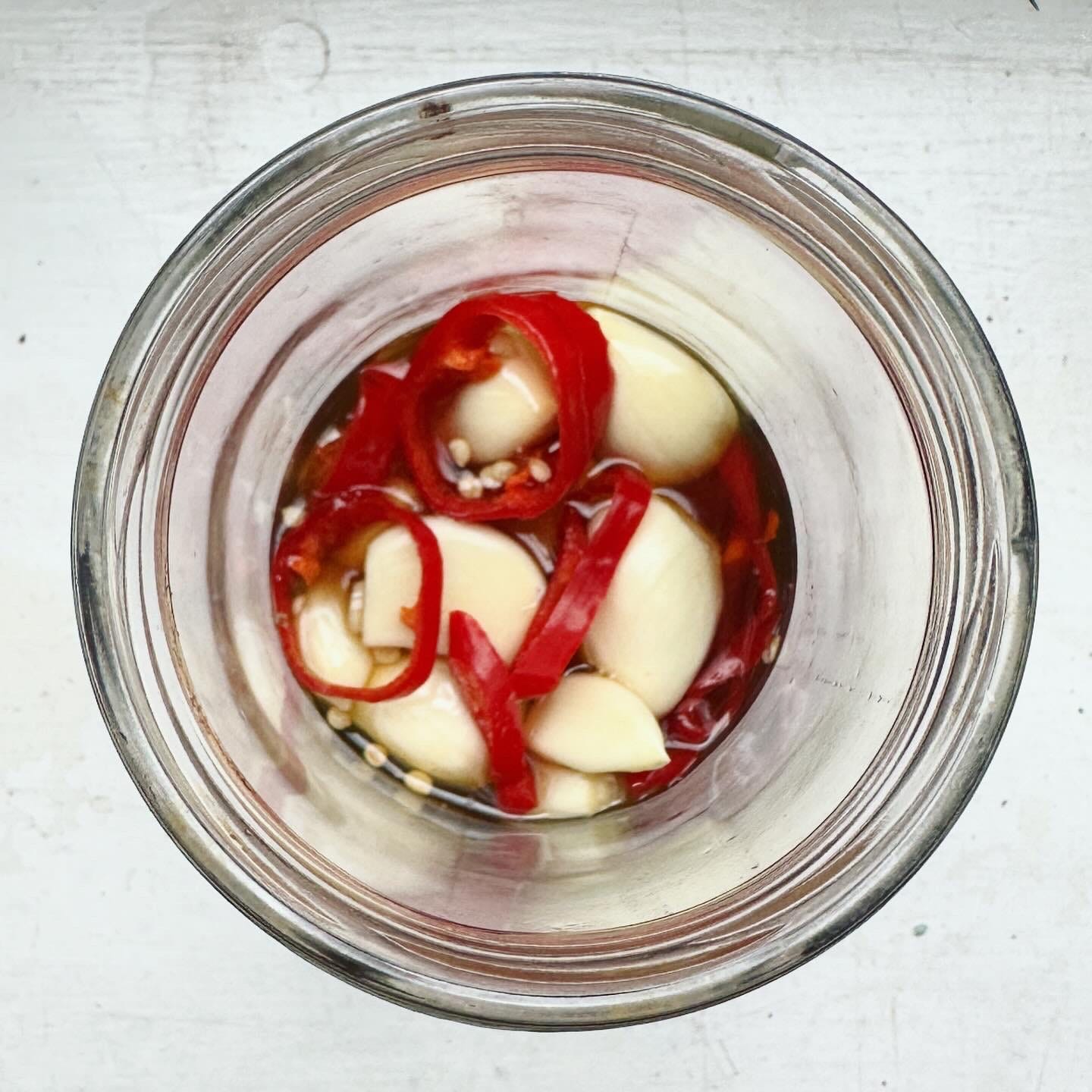In Good Taste #37: Fermented Garlic Honey
Something so absurdly easy and delicious you'd be crazy not to make a jar right now; SJP in Plaza Suite; current podcast obsessions
Well, hello there! How are you?
Good I hope. Thank you so much for being here.
(Not up for the chitchat? Completely get it. Click the email title to go to a web-based version then jump straight to the recipe, or Cultural Fun.)
It took a while but I am over my weird Covid-y cold. The cloud of fatigue lingered for nearly a week but I feel back to myself now. I was well enough to go out for dinner last night with my old boss Olivia who runs St Clements, a lovely cafe in Parsons Green where I spent a happy few months baking cakes and poaching eggs after graduating form Leiths in 2016. We went to Quality Wines in Farringdon and had a delightful time, catching up, sampling wines by the glass recommended by a charming young man called Emilio and eating delicious things.
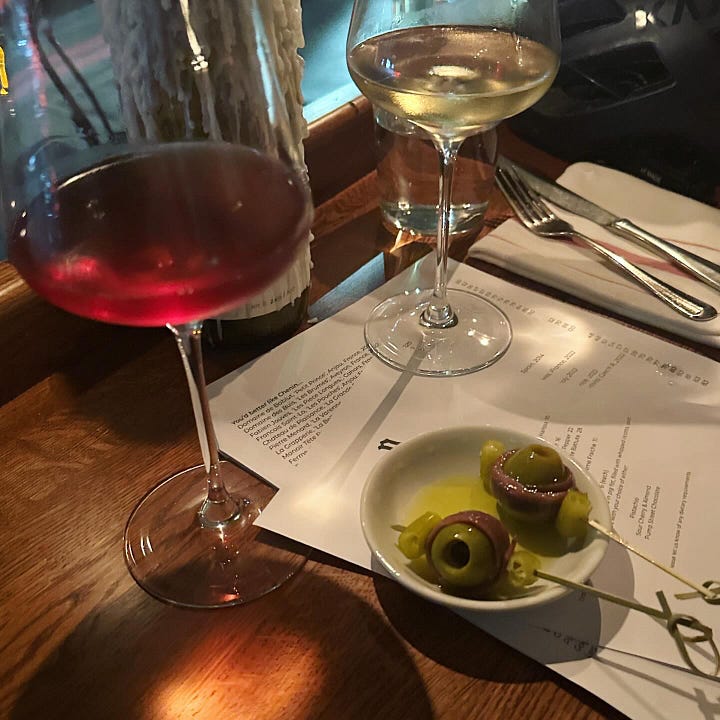

It was so dark (= atmospheric) that all my pictures are rubbish but the gilda (little skewers of pickled chilli, olive and anchovy) and the mortadella pannino were particular highlights. A real treat anyway.
Next week I will finally be ready to tell you not one but two pieces of exciting news I have been storing up about summer events. Subscribe to make sure you don’t miss them!
Fermenting Honey
Lots of people tell me that they enjoy reading this newsletter (which I love to hear - thank you!) but sheepishly add that they haven’t actually fermented anything (which is fine - no pressure! - but why not start with some sauerkraut?). This week’s recipe is so absurdly easy that I hope it will tempt a few of those people to make their first jar of joy.
We’re going to ferment garlic in honey and all it involves if putting both those things in a jar and stirring occasionally. Easy, yes? Yes. Also delicious, versatile and allegedly good for you.
The crucial thing here is to use raw honey as we’ll be relying on the natural yeasts it contains to get the fermentation going (these will all have been killed in pasteurised honey). Yeasts can remain dormant for a long time, needing only some water to wake them up and some sugar to eat once they do (think about the sachets of dried bread yeast which last more or less indefinitely).
The majority of honey is sugar (glucose and fructose) but it also contains water and traces of amino acids, vitamins, minerals and other compounds that produce its distinctive flavour including bacteria and honey. The water level is usually around 17% - not enough for fermentation to happen. But it needs only to get to 19% for those yeasts to wake up and start to ferment the sugar.
This is how mead is made. Sometimes called “honey wine”, at its simplest mead is brewed by diluting honey with water and letting the yeasts do the rest. Fruit, flowers and herbs can be added for a more complex drink.
I always loved the idea of mead. It’s probably the earliest form of human-crafted booze. There’s archeological evidence of mead production in China from as long ago as 7000 BCE. The ancient greeks and romans drank it, as did the vikings. Elizabeth I was apparently partial to a goblet or two. It’s got general fantasy-feast vibes.
A version of mead is still popular in Ethiopia and Eritrea where it’s called tej. I’ll revisit the subject again later in the summer and we’ll make some lovely fruity, floral drinks, but I bring it up now because today’s ferment is essentially a very concentrated mead.
In The Art Of Fermentation Sandor Ellix Katz says that he usually makes mead by diluting one part of honey with four parts water but that some people go as high as one to 13. Here we’re not adding any water at all but the sugar in the honey draws out water from the garlic which is enough to get us over that crucial 19% level and wake up the yeasts. The honey becomes runnier and after a couple of days you’ll see bubbles. Yes, there are plenty of bacteria in both the garlic and the raw honey but they’re being outperformed by the yeasts which is the main fermentation happening here.
We’ll get two end products, firstly the garlic-scented honey honey itself and secondly the garlic which loses its raw bite and becomes almost candied. You can start to use both from a week or so after starting the ferment but the longer you keep it the deeper and more mellow the flavour will be. I’d recommend a couple of months but I’ve heard of people keeping it for years, ending with something really dark and complex.
I said there were just two ingredients here but you can also add chilli (fresh or dried), herbs and spices too if you like.
A note on honey
A lot of honey you buy at the supermarket is not “real” honey. Most cheap jars will be all or partially composed of honey-flavoured sugar syrup and not made by bees at all. See if you can find something locally produced. There’s a surprising amount of people out there producing small batch honey. I’ve bought fantastic honey from a variety of people near me including a chap called Thierry whose garden bees produce the highly-sought-after (by locals anyway) Harringay Honey. Also, on a slightly larger scale, Timothy Charge has hives on Tottenham Marshes and Waltham Abbey in Essex and sells at various local markets.
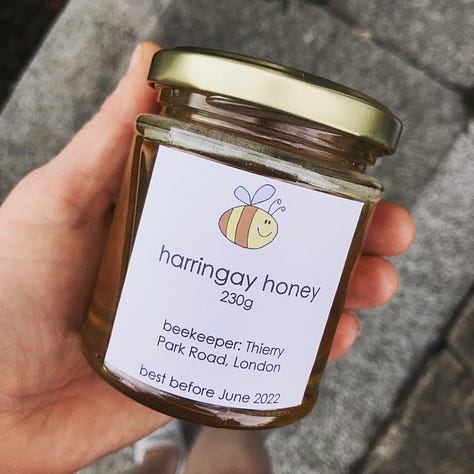
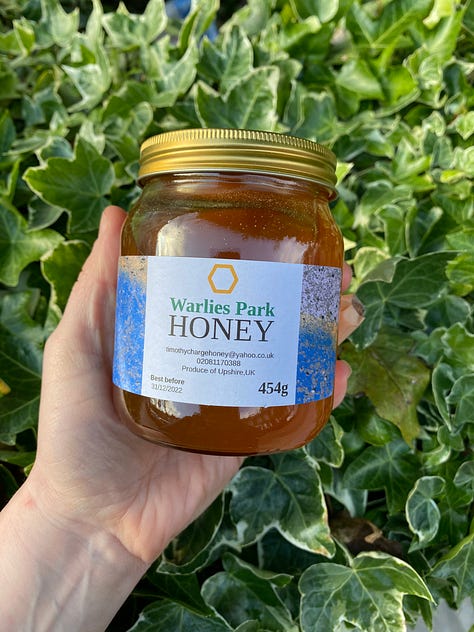
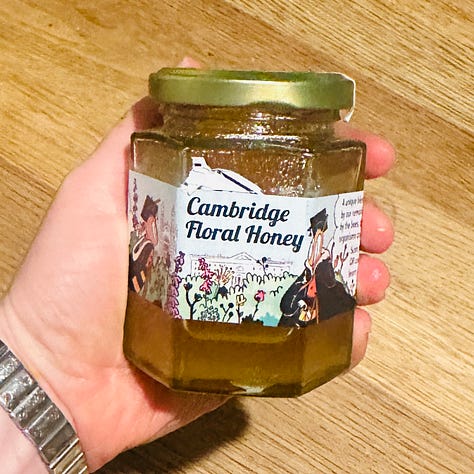
With just the tiniest amount of googling I bet you could find a local producer who would hook you up with something wonderful. For my latest batch I used a jar of Cambridge Floral Honey that I was given for Christmas. It’s made by researchers at the university who are studying how bees communicate with each other so had its natural sugars enhanced by the sweet taste of science.
A note on botulism
Botulism spores are all over the place, including on many fruits and vegetables. We eat them all the time. They’re not dangerous in themselves, only if they manage to reproduce and create botulism toxin which they can’t do in acidic environments. Honey may contain botulism spores but is naturally acidic and so are our stomachs so the risk is extremely low. Really. Don’t worry about it. And if you do you can add a spoonful of apple cider vinegar or lemon juice to your honey and garlic to ensure its acidity.
However, babies’ stomachs don’t necessarily contain high enough levels of acid to render the botulism spores harmless. Which is why it’s not recommended to give honey to children under one year old. This applies to fermented honey too. But it is perfectly safe for you.
Recipe: Honey-Fermented Garlic
How much you make will depend on the amount of honey you have. You need enough to cover the garlic which I’ve found means roughly equal weights of each. With my little jar of honey I used about 200g garlic.
garlic, peeled
raw honey (a roughly equal weight to the garlic)
chilli, herbs, spices (optional, see note)
Method
Put the garlic in a scrupulously clean jar and pour over the honey.
Seal the jar and leave at room temperature.
The garlic will most likely float on top of the honey and that’s fine. Just stir or agitate regularly (one or twice a day) to keep it coated. For the first day you’ll probably need to use a spoon. As the honey draws water from the garlic it will get runnier meaning you can just shake or swirl the jar. (Click through to my instagram post and look at the video in the third slide to see what I mean.)
After a few days you’ll start to see bubbles. Open the jar a crack every day to let out the carbon dioxide.
Over time the garlic becomes mellower, losing its bite, and the honey takes on this flavour. Your garlic honey and honey garlic will be ready to use after about a week but you can keep it going for months or even years. I recommend a couple of months for a balance between complexity of flavour and endlessly delayed gratification. The garlic cloves become golden brown as time goes on. This is natural and fine. The longer you leave it, the darker they will get.
Notes (If Ifs And Ands Were Pots And Pans…)
As mentioned above, it’s super important to use raw honey here.
You can add any flavourings you like. I am seeing “fermented hot honey” on all sorts of trendy menus right now and you can make your own by adding fresh or dried chillies. You could also add a few slices of lemon or ginger, woody herbs such as thyme or rosemary or any spices you fancy. Bear in mind that adding fresh chillies or lemons will increase the water content and make your honey more liquid.
Both the honey and the garlic have all sorts of uses. I’ll be back next week with some recipes but obvious places to start experimenting would be salad dressings and dips.
Cultural Fun
I went to see Plaza Suite at the Savoy Theatre. Much has been written about the £395 tickets to see Sarah Jessica Parker and her husband Matthew Broderick in the collection of three short plays by Neil Simon, but me and my friends got ours for £35.
It was…fine. Enjoyable but kind of slight. I suppose there’s a frisson to be had form seeing the partners in what is supposed to be one of showbusiness’ happiest marriages portray three unhappy couples, their woes all playing out in the same (seemingly cursed) hotel suite. But I wondered why they’d thrown their star power at Simon’s late-sixties period pieces which didn’t seem (to me) hugely relevant.
My group was all women in our mid-40s who had watched (and re-watched) Sex And The City at a formative age so it’s hard to see SJP without thinking of Carrie Bradshaw. In a recent New Yorker profile SJP demonstrated to the interviewer the difference between how she herself runs in heels and how Carrie runs in heels and you could see that she put a lot of effort here into physically distinguishing the Plaza Suite characters from Ms Bradshaw. But, just occasionally, in a twirl or a shrug, there she was.
James and I managed to see both Poor Things and Killers of the Flower Moon before Sunday’s Oscar ceremony. I’d been worried about the former as I had admired but not loved Yorgos Lanthimos’ previous films and was dreading the latter because of its length. But I enjoyed both. Especially Poor Things which reminded me, visually at least, of the massively underrated Mood Indigo.
I have podcast recommendations too and it seems apt, post-Oscars, that they are both film-related. Malcolm Gladwell’s Revisionist History is running a very entertaining mini-series called Development Hell telling the stories of films that were, for a while, the talk of Tinseltown town yet never got made. I particularly liked this week’s episode about Bubbles, the Michael Jackson story told from the point of view of his chimpanzee!
More seriously, Who Trolled Amber from Tortoise is about how public opinion about the actor and her courtcase vs ex-husband Johnny Depp may have been manipulated by online bots. Reporter Alexi Mostrous (who always does great investigate work) takes what, on the face of it, seems a slightly frivolous story and makes it clear that something more sinister is at play.
Bye! See you next week!
In the meantime, if you felt like sharing In Good Taste with friends or family who might enjoy it, you can do so with the button below. It would mean the world to me. Thanks so much.
In Good Taste is a Sycamore Smyth newsletter by me, Clare Heal.
You can also find me on Instagram or visit my website to find information about my catering work, cookery lessons and upcoming events.




